Mass murder on the Zhytomyr highway: map, chronology and investigation of Russian war crimes
"We must recover the name of every person
who suffered from war crimes.
Because a human being is not a number,"
human rights activist Oleksandra Matviichuk.
Dmytrivka is a small village just a few kilometres north of the Zhytomyr highway that connects Kyiv to Chop, a town near the Hungarian border. It’s the site of a dumping ground for cars that Russians shot and burned during the siege of Kyiv. It is one of dozens of dumps in the Kyiv region.
"After the de-occupation, about fifty cars were brought to Dmytrivka," say operatives of the Main Directorate of the National Police of Ukraine in the Autonomous Republic of Crimea and the city of Sevastopol (Ukraine has retained law enforcement agencies that worked in the territories that are now temporarily occupied — ed.)
Translation: Anastasiia Marushevska
Читати українською
Of these 50 cars, 11 were retrieved from the M-06 motorway, spanning the area between the villages of Myla and Mriya. The M-06 motorway, also known as the Kyiv-Chop highway or the Zhytomyr highway, has recently been dubbed the "Highway of Death." For those who journeyed on it during the initial days and months following the de-occupation, it's no longer seen merely as a typical route to the west of Ukraine. Instead, it evokes images of charred vehicles, mourning individuals, bodies strewn on the tarmac and verges, devastated homes, heaps of Russian machinery, and warning signs for mines along the woodland strips.
The reason for the last stop of these 11 vehicles was Russian soldiers from the 2nd Battalion of the 5th Separate Tank Brigade, who arrived in the Kyiv region from the city of Ulan-Ude. Throughout March, they killed civilian drivers, passengers and pedestrians near the UPG petrol station on the Zhytomyr highway. They knew they were committing a crime: after the murders, the Russians burned all the cars and bodies to hide the traces of their crimes. "No body, no case," was probably the principle that guided the soldiers from distant Buryatia.
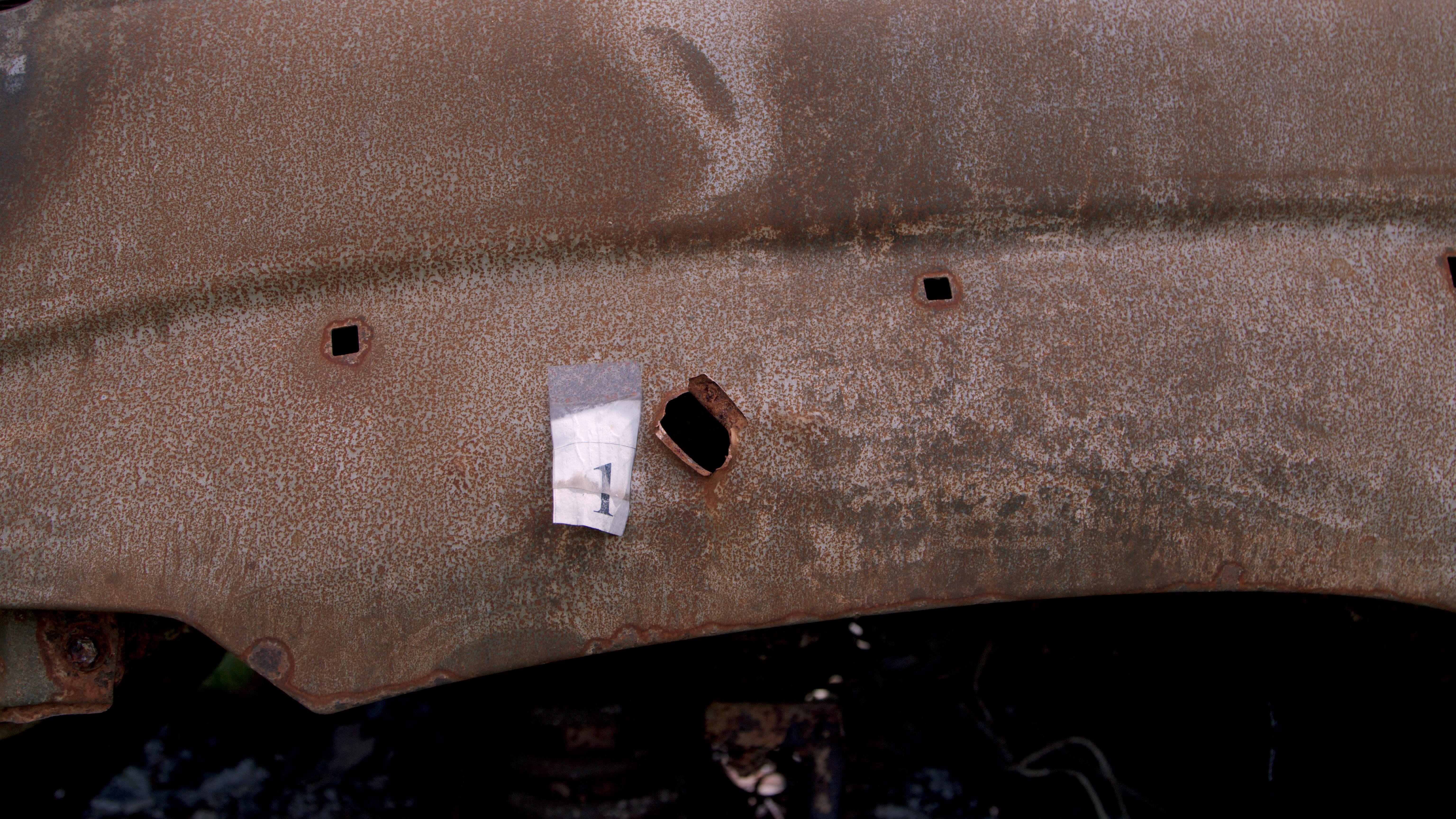
Months of efforts by the police, prosecutors, forensic specialists, military personnel, and journalists have enabled the identification of dozens of victims, reconstruction of the sequence of events, and pinpointing specific Russian commanders and soldiers alleged to have committed war crimes.
From the massacre site, the administrative boundary of Kyiv is a mere 7 km away.
Скрольте


CHRONOLOGY
"The 2nd Battalion of the 5th Separate Tank Brigade of the 36th Combined Arms Army was located right here where we are standing. It belongs to the Eastern Military District under the command of Colonel-General Oleksandr Chaika," say Alina Mashkina and Andrii Vyshniak, Crimean investigators working on the case under the supervision of the Prosecutor General's Office, standing near a UPG petrol station on the Zhytomyr highway.
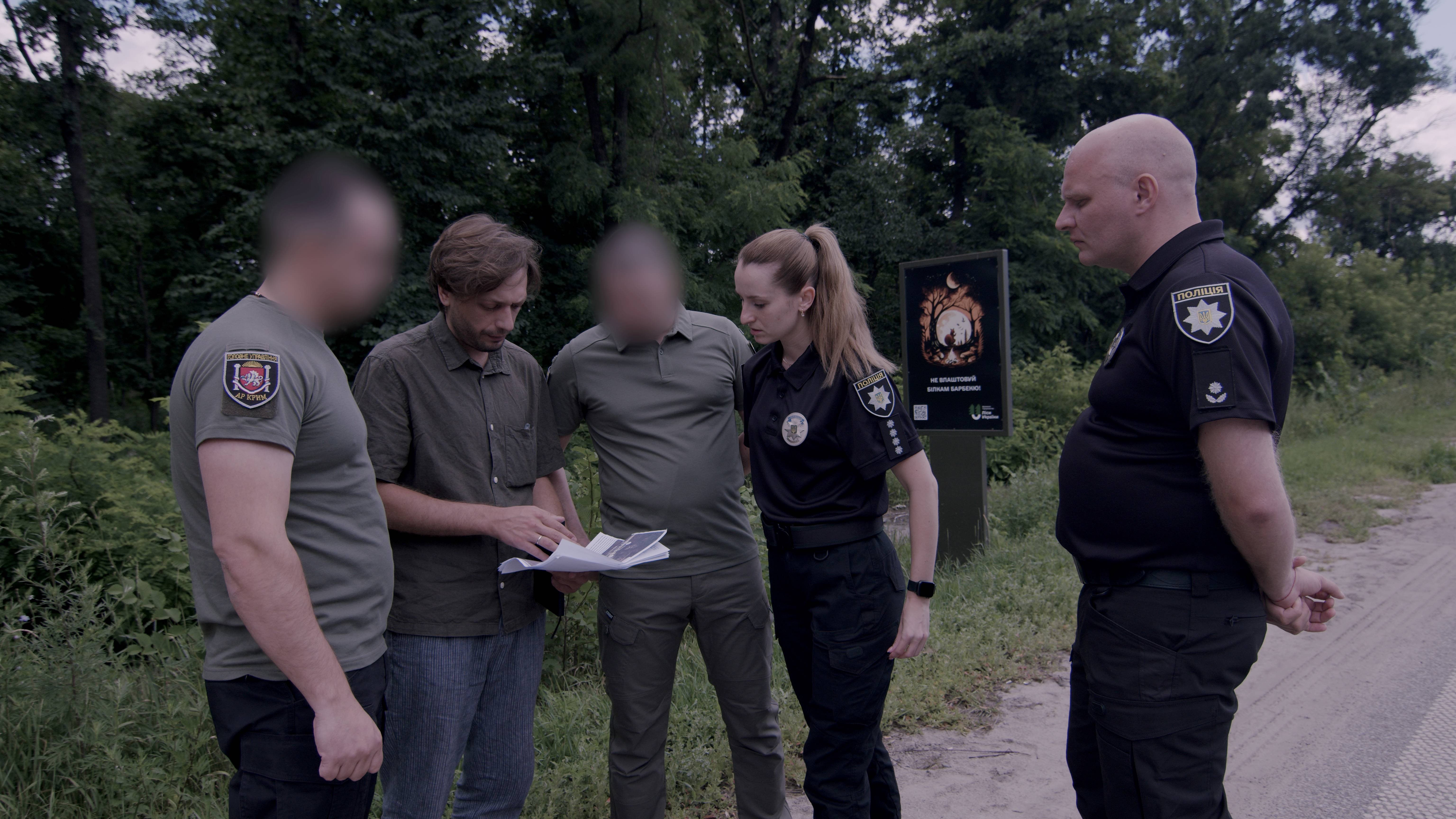
3 March, arrival of the 5th Brigade


A convoy of Russian vehicles drives up to the UPG petrol station and begins to set up its positions. There are tanks, armoured personnel carriers and soldiers with automatic weapons. They are building firing points, trenches and dugouts, and digging in equipment.
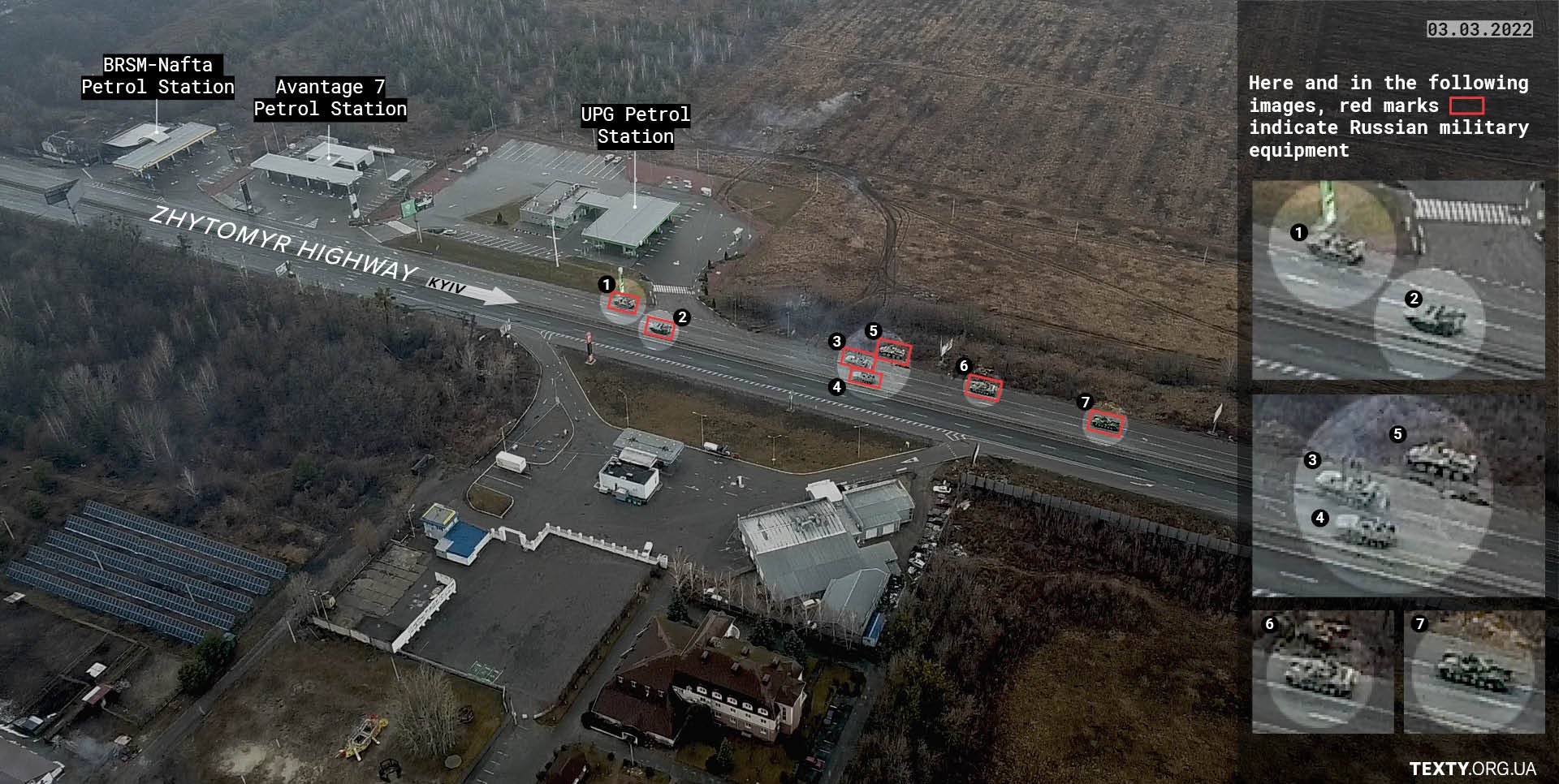
In March, drone footage of this section of the road was taken almost daily by local territorial defence fighters. Their footage makes it possible to establish the movement and location of Russian troops and Russian equipment.
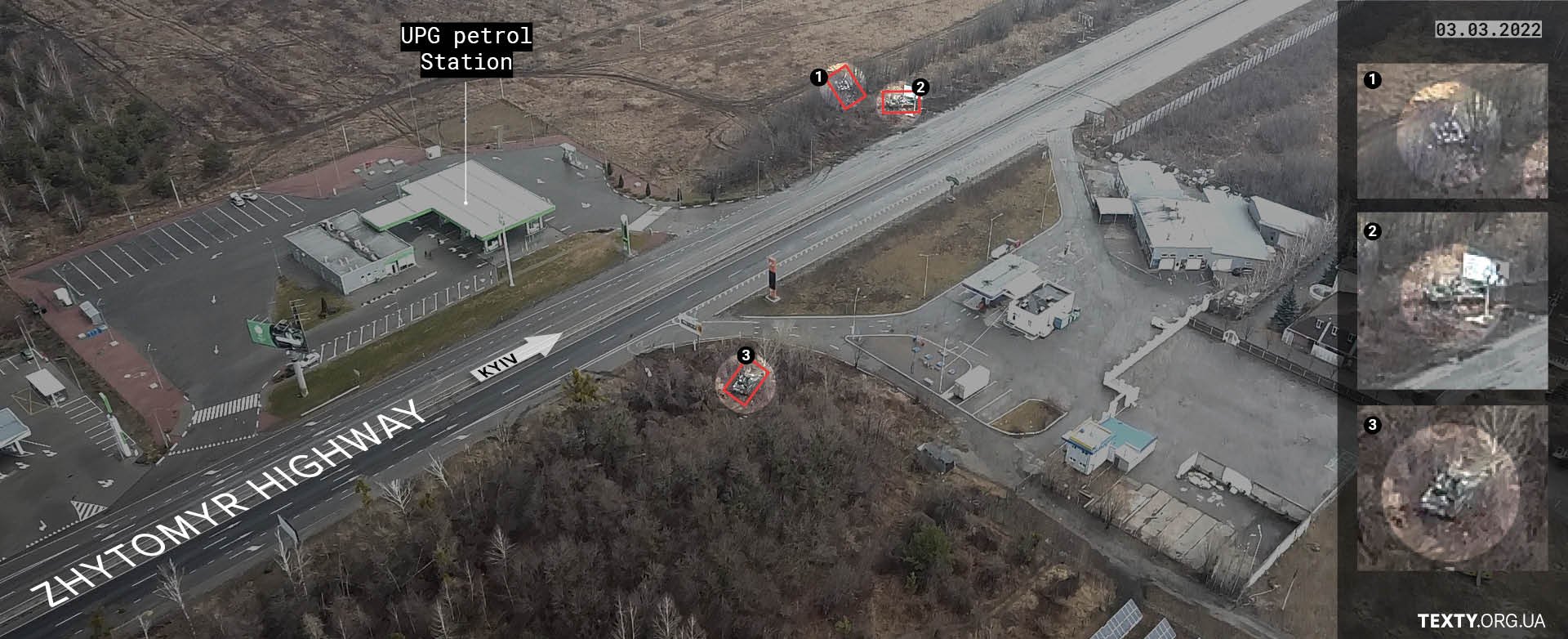
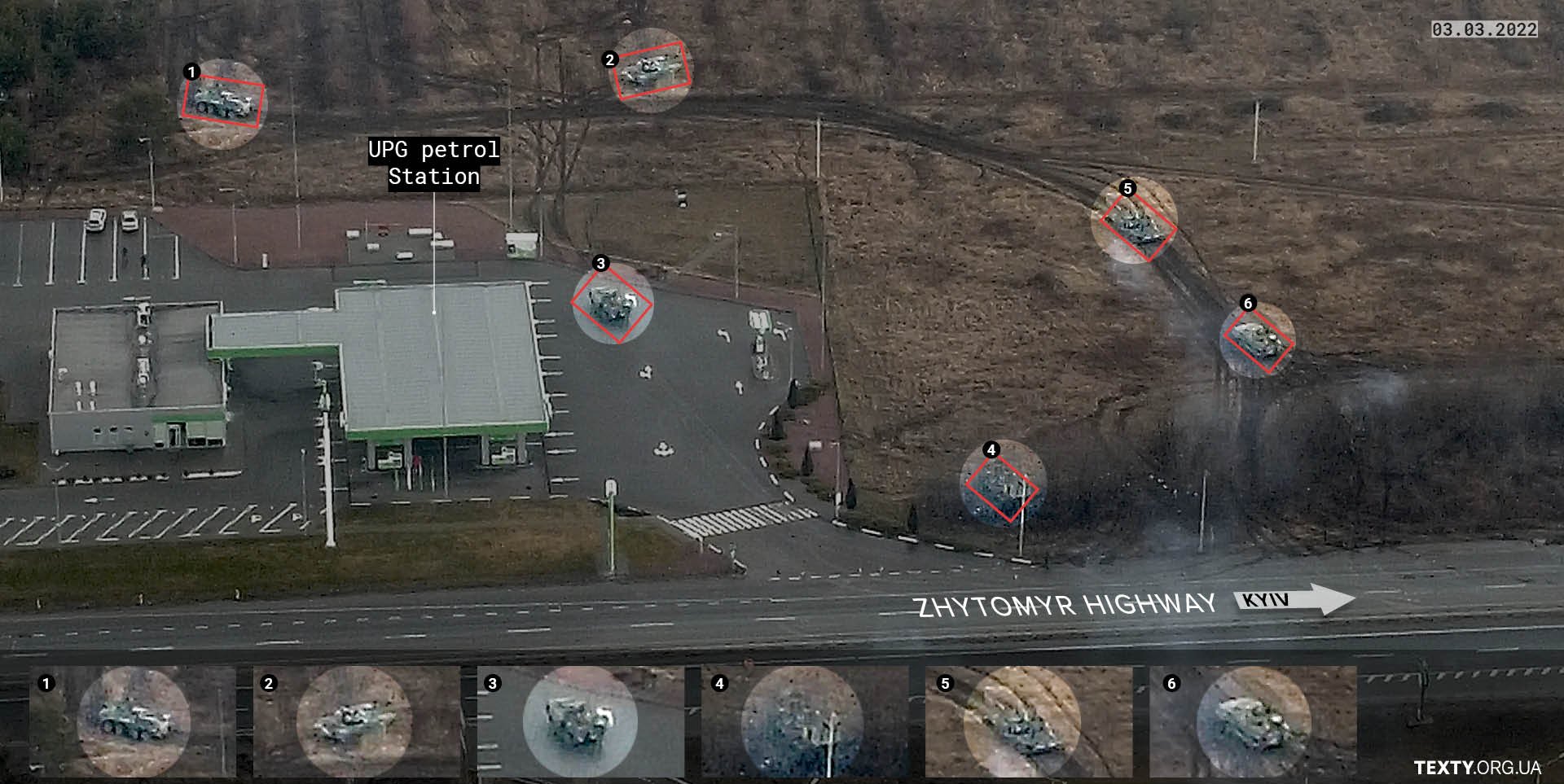
The Russians started killing immediately — on 3 March. The day they arrived in the village of Myla, the murder of one person was documented.
Anatolii Dreval is likely to be the first person killed
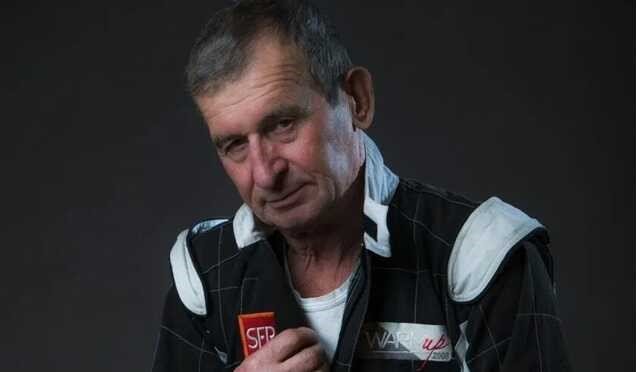
While reconnoitring the area, the Russian military could not help but come across a buggy centre right next to their positions. There, they met the owner of the centre, a stuntman and European and USSR champion in automotive all-around, Anatolii Dreval. The man not only worked here but also lived here. And on the threshold of his own home, he was shot in the head no later than 3 March 2022.
4 March, (at least) nine killed, three wounded


Together with operatives of the Crimean Main Department of the National Police, we went to the place where the first cars were shot. It was here that law enforcement officers found the first direct witnesses: "foresters, as we call them." These "foresters" are people who live literally next to the road in a wooded area. On 4 March, through the still bare trees, they could clearly see the road nearby, the Russian military and their targets. In particular, the Kia Stonic car.
The Stotsky family in their Kia Stonic
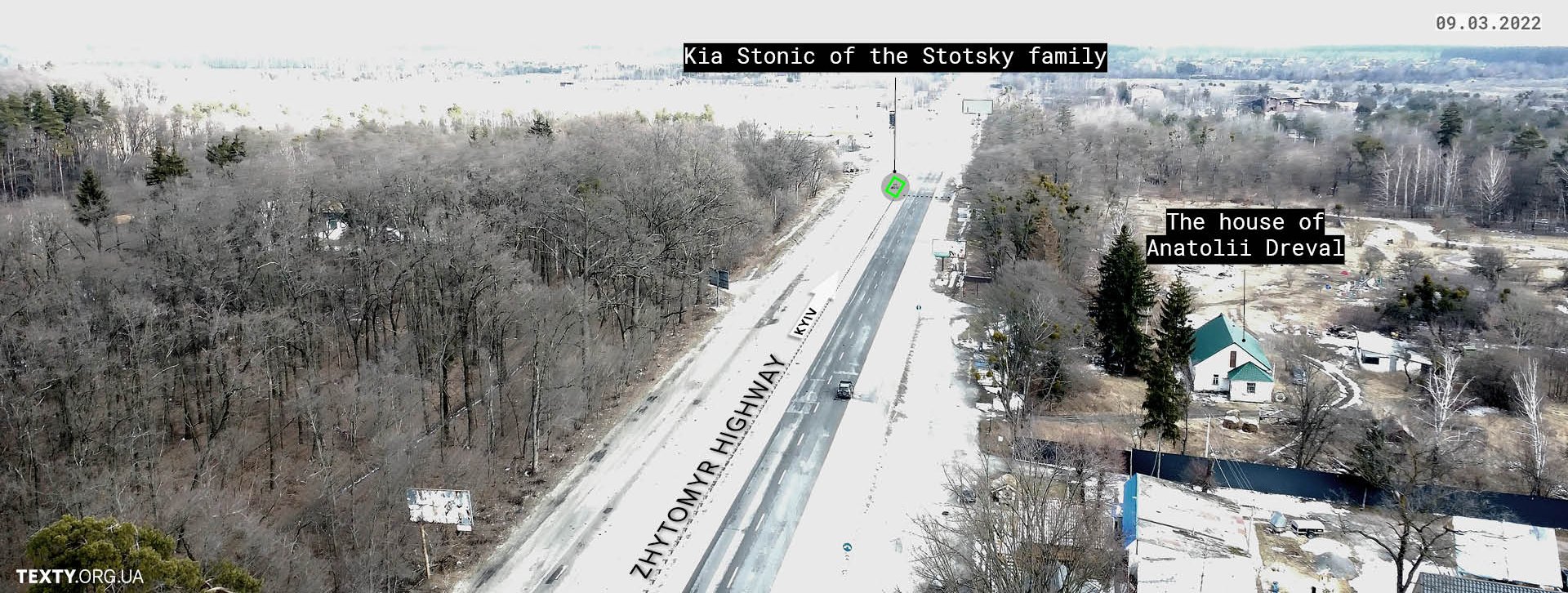

The Stotsky family, a married couple, Olena and Serhii, were trying to evacuate Kyiv in a Kia Stonic with their little daughter. They were shot near a UPG petrol station. The car drove a few hundred metres further, but stopped under the endless stream of bullets. All this time, the mother, Olena, was covering her child.
Serhii took his daughter in his arms and got out of the car. Only then did he realise that his wife was dead. "Go and look for your people," he was awakened by the voice of one of the Russian servants who was approaching the car.
The wounded man with his wounded child (gunshot penetrating wound to the abdomen, shrapnel wounds to the ankle and upper jaw) in his arms was forced to walk towards Zhytomyr. Before they could get far, they heard gunshots behind them again: the same Russian servicemen were shooting at a car with Olena's body in the back seat. "They shot so that the car burned down. There were many hits in the area of the tank," Crimean investigators say. The drone footage and witnesses' testimonies confirmed this fact.
In this and the following videos, police officers are inspecting the Zhytomyr highway in early April 2022. A Kia Stonic is seen here. The police officer made a mistake, assuming it was a Ford. Video: DENOTAT documentary group.
The car burned to the ground. So did Olena's body. Later, genetic samples were taken from a small number of her remains, and the rest were buried under a number in a nearby cemetery. Later, experts found a match in the DNA samples. The body was exhumed. Serhii reburied Olena.
The Toloks in their Toyota RAV-4
Along with the Stotsky family, their friends, the Toloks, were evacuating from Kyiv to Zhytomyr in a Toyota RAV-4: Dmytro and Diana. Under a downpour of bullets, their car stopped near a UPG petrol station.
Dmytro escaped injury, while Diana received a shrapnel wound to her right shoulder. The Russians detained the couple for a while but then released them. But Diana and Dmytro, in addition to the Russians, were also terrified for their friends, the Stotsky family. They decided to ask about them. "The man and the child have already left," they heard in reply.
The Toloks ran towards Zhytomyr and soon caught up with Serhii with his wounded daughter in his arms. They walked a few hundred metres together and came across Volodymyr Nikolaychuk, a volunteer from the village of Mykhailivka-Rubezhivka who had rescued hundreds of people from the Zhytomyr highway and nearby villages in March. He took them to a hospital in Borodianka, where doctors treated them. Thanks to his help, the Stotsky daughter, her father Serhii, and the Toloks survived.
Vasyl Harashchuk, 80, driving a Volkswagen Passat
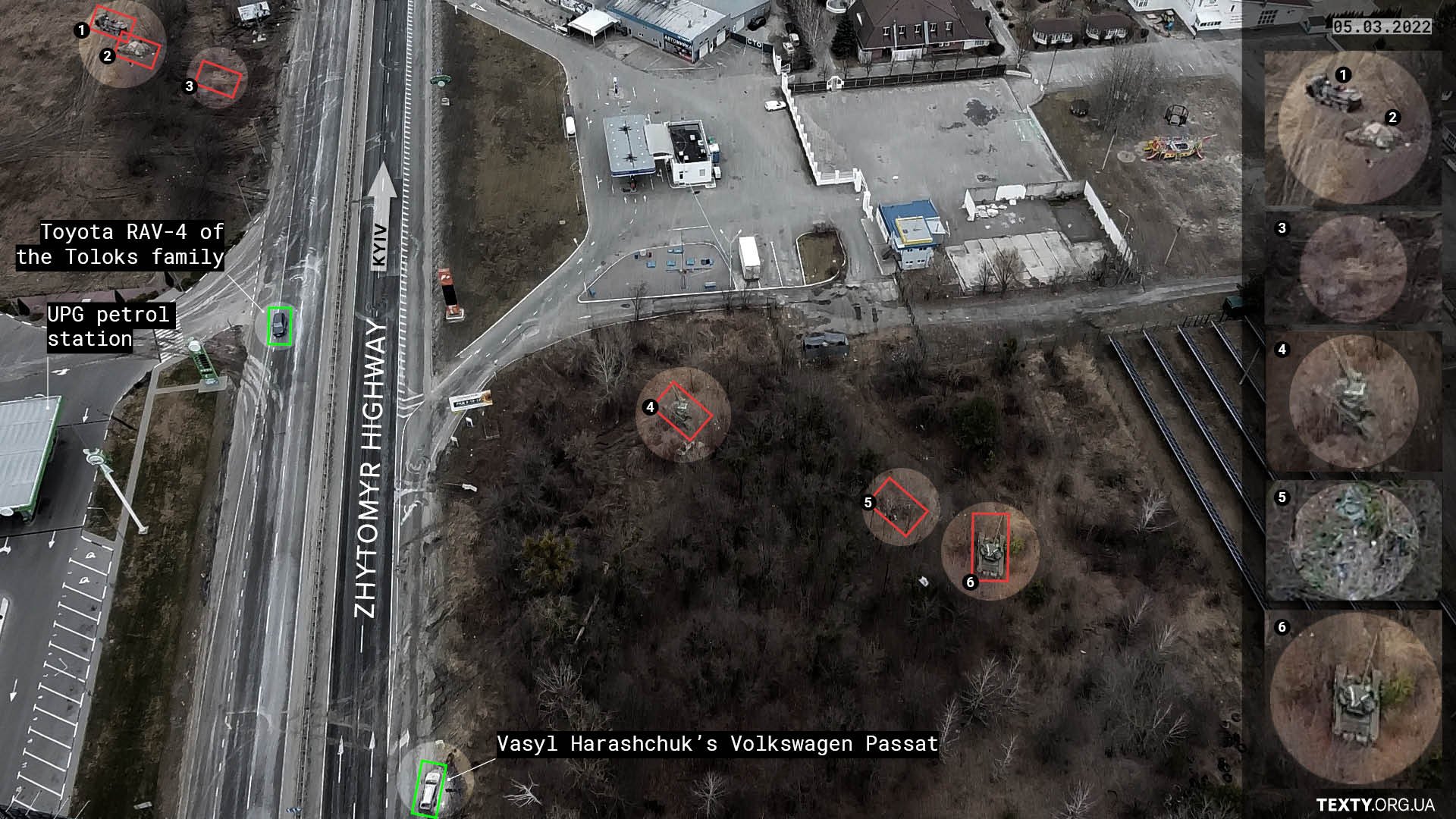
The Russians allegedly fired at a Volkswagen Passat driven by 80-year-old Vasyl Harashchuk on the same day. In the morning, the man was still at his dacha in the village of Berezivka, further west on the Zhytomyr highway, but decided to go to Kyiv to visit his daughter. He died of multiple bullet wounds.
Initial review of the Volkswagen Passat. Video: DENOTAT documentary group
Valentyn Hrabchak and Olena Husakovska in a Renault Duster
On the same day, Valentyn Hrabchak and Olena Husakovska tried to evacuate from a nearby dacha cooperative.
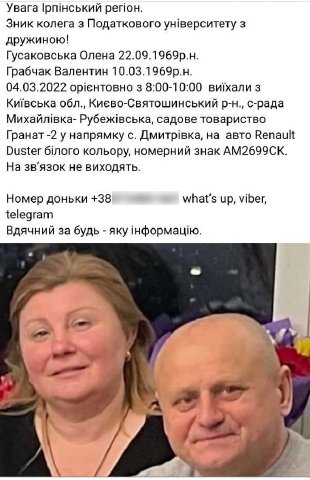
Their car was also shot at, and Valentyn and Olena died on the spot. A few days after the shooting, the Russians set fire to the car with the bodies.
Initial review of the Renault Duster. Video: DENOTAT documentary group
Territorial defence fighters on a Mitsubishi Pajero Sport
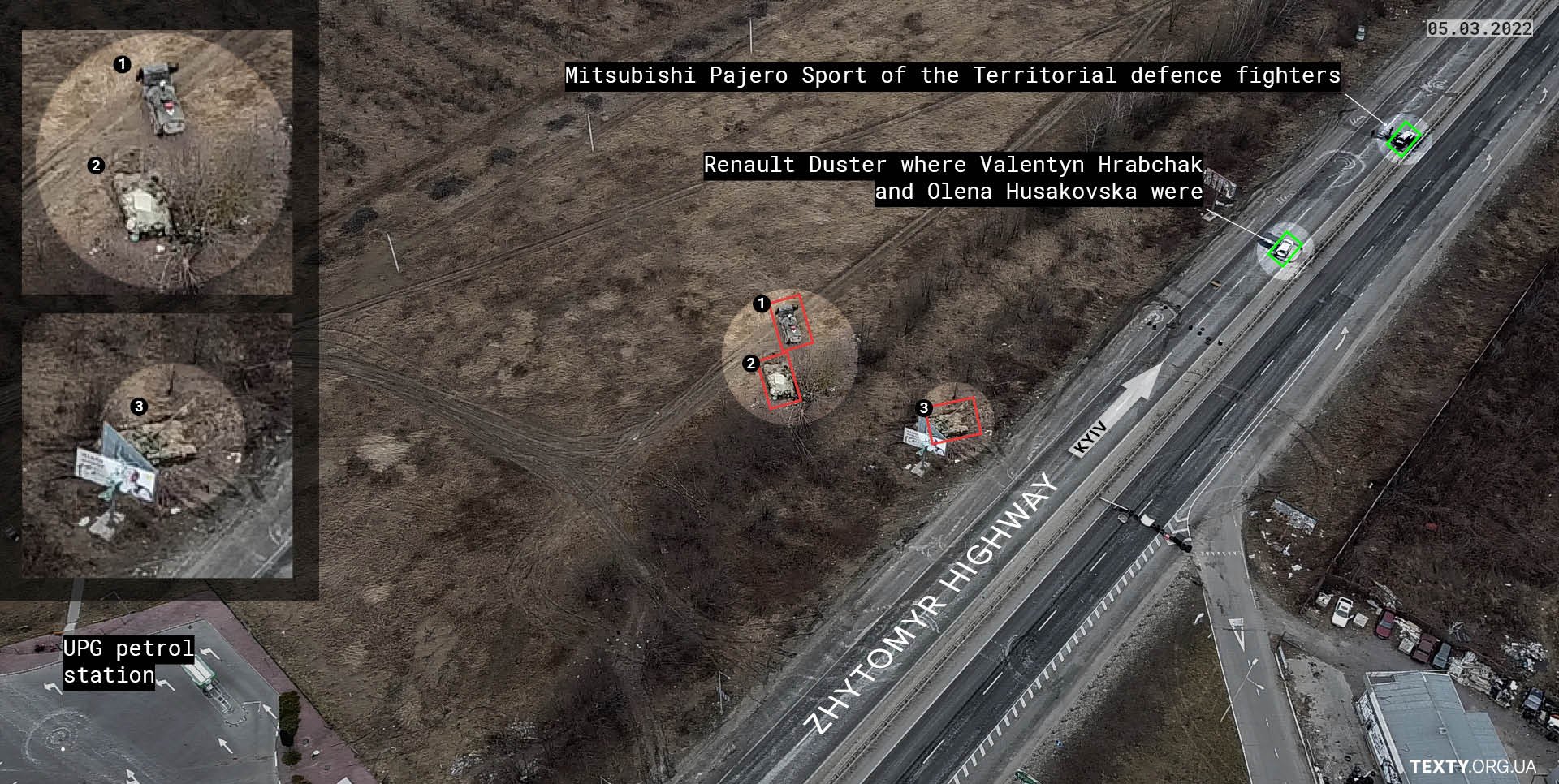
The shooting of this car will probably not be classified as a war crime, as there were combatants from the local territorial defence: Vasyl Kozlov, Oleksii Kazymir and Mykhailo Boichenko. Their checkpoint in the Stoyanka area was shelled, and the men decided to change their position and drove west along the Zhytomyr highway. All three were killed on the spot.
Initial inspection of the Mitsubishi Pajero Sport. Video: DENOTAT documentary group
Toyota RAV-4
Another Toyota RAV-4 was shot that day. The driver and passenger managed to escape.
Pedestrians
In addition to cars, on 4 March, Russians shot two more Ukrainians who were travelling on foot. They were Volodymyr Panov, born in 1967, and Oleksii Dudnyk, born in 1976.
The burnt body of Volodymyr Panov, along with three unidentified bodies, was found on the roadside. They were all piled together and covered with tyres. The results of the forensic examination showed that Volodymyr Panov died of a head wound.
The exact place where Oleksii Dudnyk died has not yet been established. His last known location, based on his mobile phone traffic, was near a UPG petrol station.
Initial inspection of four bodies on the roadside of the Zhytomyr highway.
Warning: The video contains footage that may be shocking. Video: DENOTAT documentary group.
We are publishing it in the hope that the bodies of the unidentified people can be identified.
In total, at least five cars were shot at on 4 March, and two people on foot were killed. In total, three people were injured and nine were killed.
5 March


On that day, Russians shot dead Oleksandr Shelykh, a civilian man who was walking from the village of Shpytky towards the village of Myla. He died on the spot from a penetrating gunshot wound to the abdomen and head.
07 March, (at least) three killed, two wounded

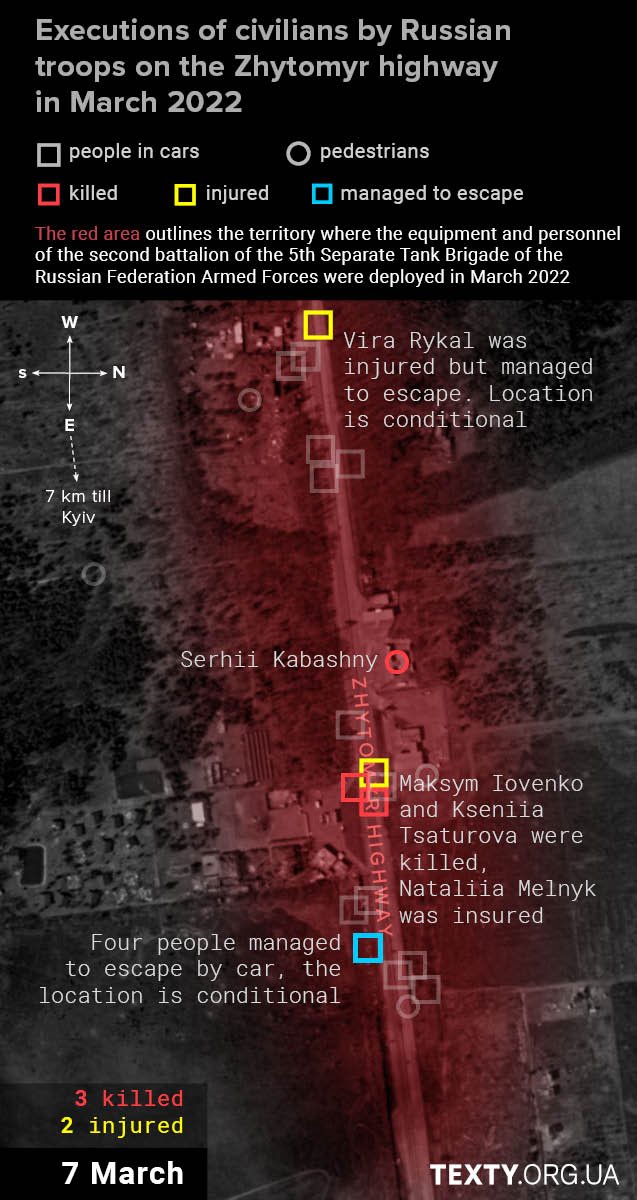
"There are children here! Children!" — signs on Hyundai i30
An evacuation convoy of civilian vehicles was moving along the Zhytomyr highway towards Kyiv. The number of vehicles gradually increased as new cars of civilians seeking to escape the war joined the convoy. Not far from the village of Mykhailivka-Rubezhivka, a Hyundai i30 with "Children" stickers on the windscreen and rear window joined the convoy.
Maksym Iovenko was driving with his family friend Nataliia Melnyk in the passenger seat next to him, his wife Ksenia Tsaturova, and their 5-year-old son Hordii behind him.
Opposite the UPG petrol station, the Russians started shooting at the convoy, and the vehicles turned around; some were lucky to escape the fire.
Maksym's car did not escape — his Hyundai i30 stopped. Maksym jumped out in front of the car with his hands up and started shouting at the Russians to stop shooting. But he was shot dead. And his wife Ksenia, who was covering her child, was also shot. Nataliia Melnyk was wounded in the shelling.
A drone video shot by local territorial defence fighters shows Russian soldiers firing at a Hyundai i30. The footage shows how Maksym Iovenko is shot, standing in front of the car with his hands raised, how bullets hit the car's rear window, and how the Russians take Nataliia Melnyk and the son of Maksym and Ksenia to their commander. You can also see that Maksym Iovenko did not die immediately after the shooting, he moved his arms several times, but the Russian military did not assist him but only dragged the wounded man to a place less visible to potential witnesses.
A few months later, we met Nataliia Melnyk at the shooting scene where the Crimean police were conducting an investigative experiment with her participation. During the experiment, the woman stoically recreated and told everything she had seen and experienced: the moment Maksym was killed, saving the child from further shelling and talking to the Russians and their commander.
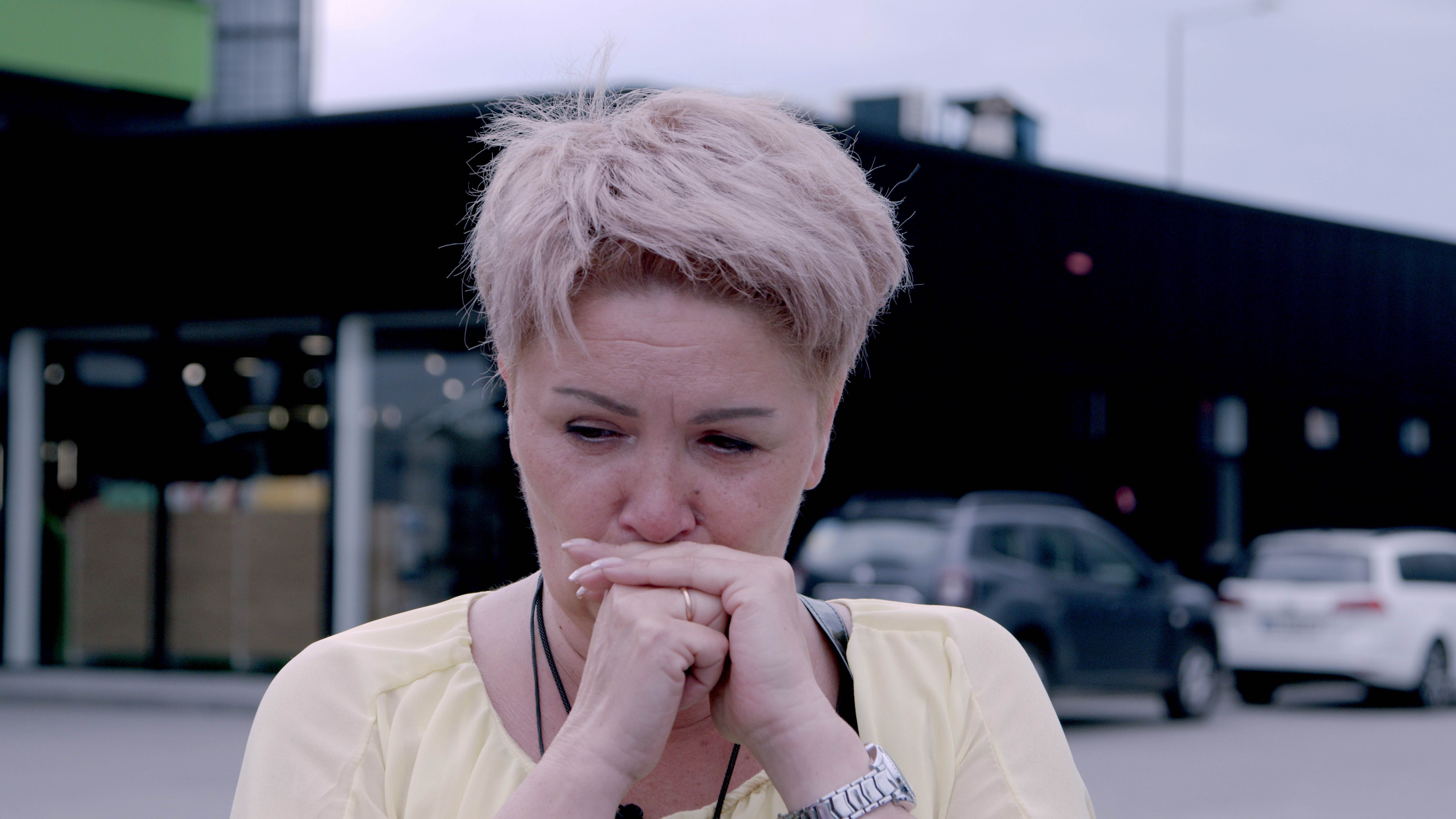
The following is a direct speech by Nataliia Melnyk:
We were driving in the opposite lane. Men were planning a route there somehow. Almost as soon as we got to this area, we heard shots... there was smoke and sand... everyone turned around, and so did we. But shots, shots, shots, constantly shots. We stopped, the car was not going anymore. Maksym jumped out and started waving: "There are children here! Children!"
It was all in front of me. He fell down. Kseniia started to wheeze. She wheezed once, twice. Hordii said: "Why is mum wheezing?" I turned, took Hordii, while they continued shooting. I take him. I also think, "How is he going to get unbuckled?" [unbuckle his seat belt]. But somehow, he did it on his own or something. And I take him with my hands, but he doesn't fit between the two seats here [the front ones].
So, I took him. Then I put him [in the driver's seat] and covered him like this [with myself]. I realised it was painful for him to lie there, so I pushed him even lower [under the steering wheel]. And that's how I got the bullet [points to her right forearm]. And I was lying there like that. And they were shooting. I was getting lower and lower. And they were shooting for so long. I don't know how long they were shooting... I was lying there and thinking, "It needs to end at some point."
And then there was silence. So quiet, so quiet. I quietly opened the door and saw Buryats standing there. They were standing with assault rifles... Not Russians... Russian Federation soldiers... We don't have them [Buryats] here so I realised they were Russians. I opened the door and said right away, "There are children here, don't shoot, please, there are children here."
And they said, "Send the child forward." Hordii got out, but I couldn't get out of the car fast... When I got out, I saw Maksym's [Iovenko's] legs. I wanted to go to him, but he [the Russian] still stood there and did not let me pass. He said, "That's it! That's it!" I started saying, "Kseniia is here! Mum is behind!" And I stood there like this. And he looked at something and was like: "Cover the child's eyes." I covered Hordii's eyes with a shawl, I did. And he took us there, in that direction [points to the area behind the UPG petrol station].
There was a pit there. I saw it right away. I asked [the Russian who brought them]: "Are you serious now? Don't do that." And he said: "I'm sorry. My child is also six years old. I'm sorry." I thought they would shoot us... But behind the pit, this Russian officer appeared and shouted, "Who opened fire? Who shot? Who brought her here?" I started to tell him that "We were on our way, we evacuated, they are shooting... we have children...", "You had no identification marks" [Russians said], I said: "What do you need identification marks for if we had white [flags]... (crying) and 'children' both in front and behind."
Everyone was listening to him [this officer] it turned out later that it was Tkharo Abatayev)... Someone behind me said, "What should we do with them?" He looked me in the eye for so long and then answered, "Let them go."
They took us out through that petrol station [Avantage], and we went with Hordii already... And Buryat took Hordii in his arms and asked: "What's your name?", "Hordii", "I'm sorry, I know you won't forgive me, but I'm sorry." I think he was the one who shot and killed Hordii’s parents...
With the child in her arms, Nataliia Melnyk walked west along the Zhytomyr highway. After a while, they were picked up by the same volunteer from Mykhailivka-Rubezhivka, Volodymyr Nikolaichuk, who had helped the Toloks and Stotskys on 4 March.
After the shooting, the Russians burned the car and the bodies of Maksym Iovenko and Kseniia Tsaturova. Video: DENOTAT documentary group
Jeep Compass
A Jeep Compass was travelling in the same convoy as the Hyundai i30. Vira Rykal, her husband and her elderly mother were in it. They also began to turn around when the shelling started, but they managed to escape almost unharmed. Only Vira Rykal, although ducking, received a bullet wound to the back.
Subaru Outback
There were four people in this car, they decided to evacuate that day and were moving in the same convoy as the Hyundai i30 and Jeep Compass. Near the UPG petrol station, the vehicles came under Russian fire. The driver of the Subaru Outback immediately got his bearings, turned around and drove off at full speed towards Zhytomyr.
Several bullets still hit the car, piercing the headrest, so if the passengers had not laid down, they could have been injured at least. Luckily, all four of them got out of the shelling unharmed.
Serhii Kabashny in a Ford Transit
The body of Serhii Kabashny was found at the entrance to the Avantage petrol station next to UPG. He was driving his Ford Transit along the Zhytomyr highway. The Russians apparently first stopped the car and then shot Serhii in the head right at the petrol station. After that, Russian soldiers appropriated Serhii Kabashny's Ford and used it until 19 March.
The body of Serhii Kabashny at the entrance to the Avantage petrol station. Video: DENOTAT documentary group
On 19 March 2022, the Russian military used this car to drive to the Camper Group car dealership, a few kilometres west along the Zhytomyr highway. There, they shot two more civilians: the owner of the car dealership, Serhii Muravitsky, and his friend Leonid Plats, who helped with security. On 24 August 2022, Crimean police investigator Vladyslav Kaminsky, in agreement with prosecutor Roman Pshyk, served a notice of suspicion on Nikolai Sokovikov, a Russian soldier of the same 5th Separate Tank Brigade.
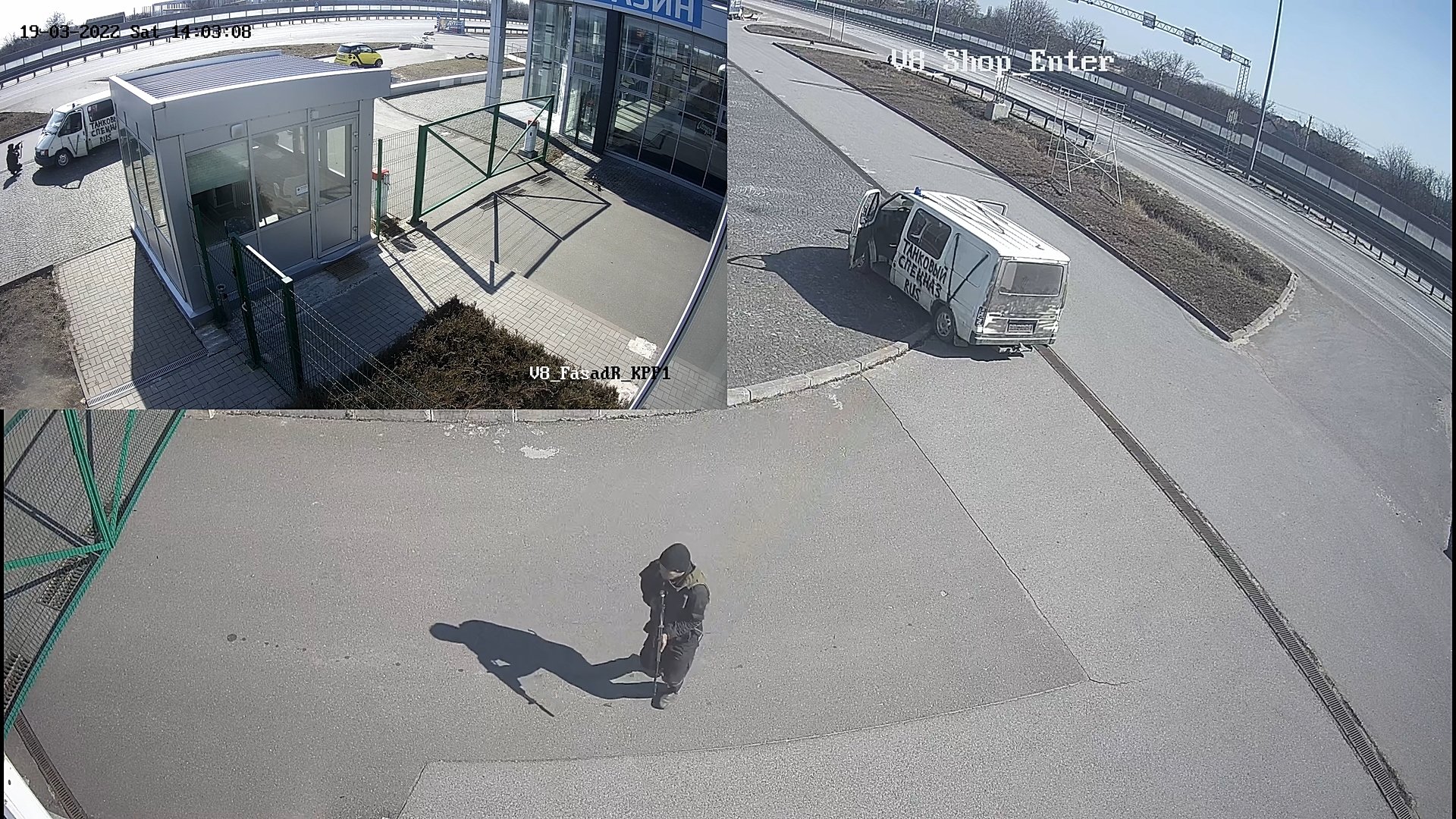
In total, at least three people were killed on 7 March and two others were injured.
8 March


On that day, a local resident, Bohdan Komarovsky, died of gunshot wounds to the head and body. He was returning from friends to his home in the village of Myla.
11 March, convoy passage
On this day, people managed to negotiate with the Russian military to allow a convoy of civilian vehicles to pass through. They set up a kind of checkpoint near the UPG petrol station, where they checked all the people who were evacuating. And not only checked them, they took all the household appliances and put them in a specially prepared container: phones, tablets, laptops, etc. They were not interested in money, only in the equipment. They allowed some people to take SIM cards from their phones.
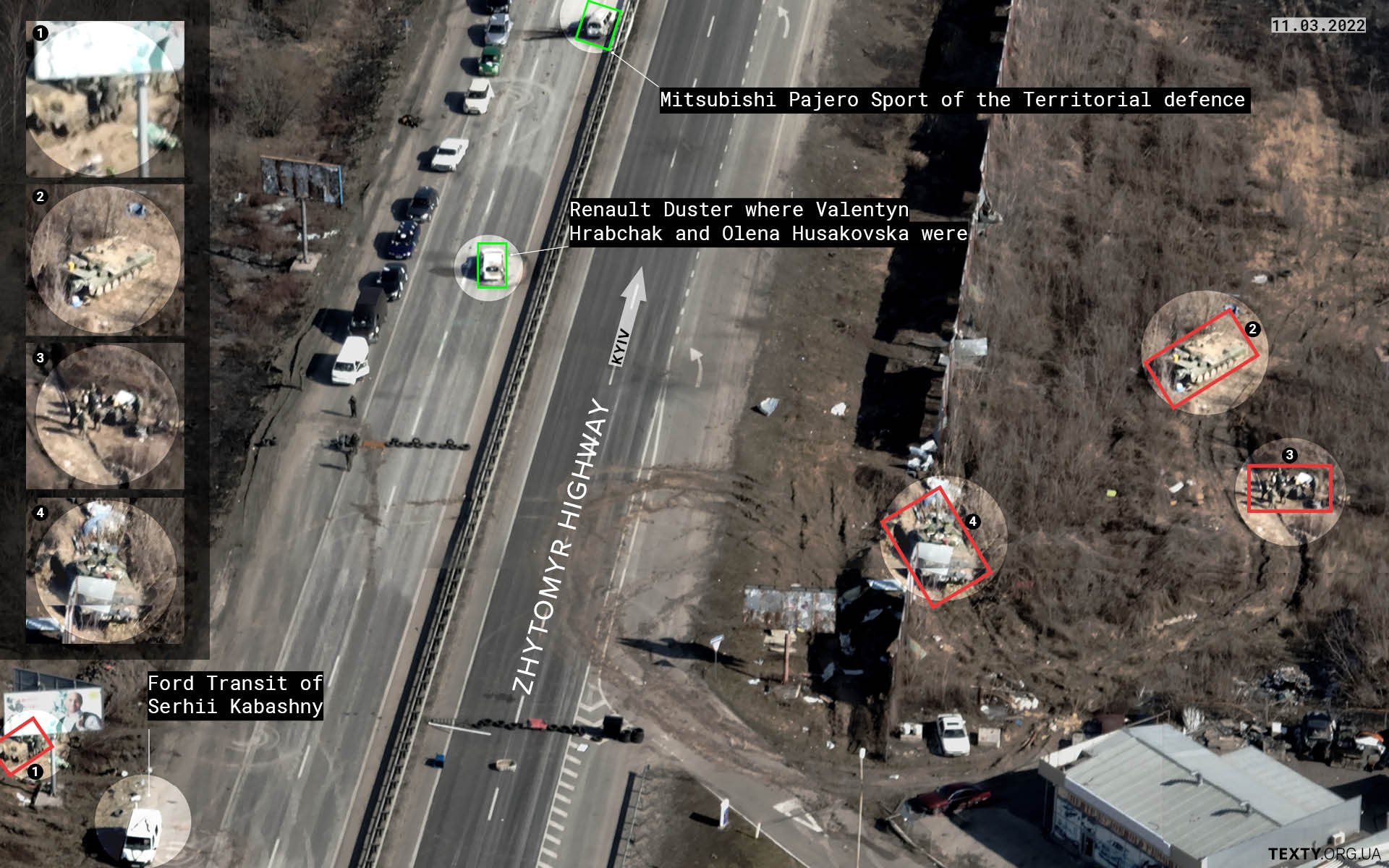
13 March

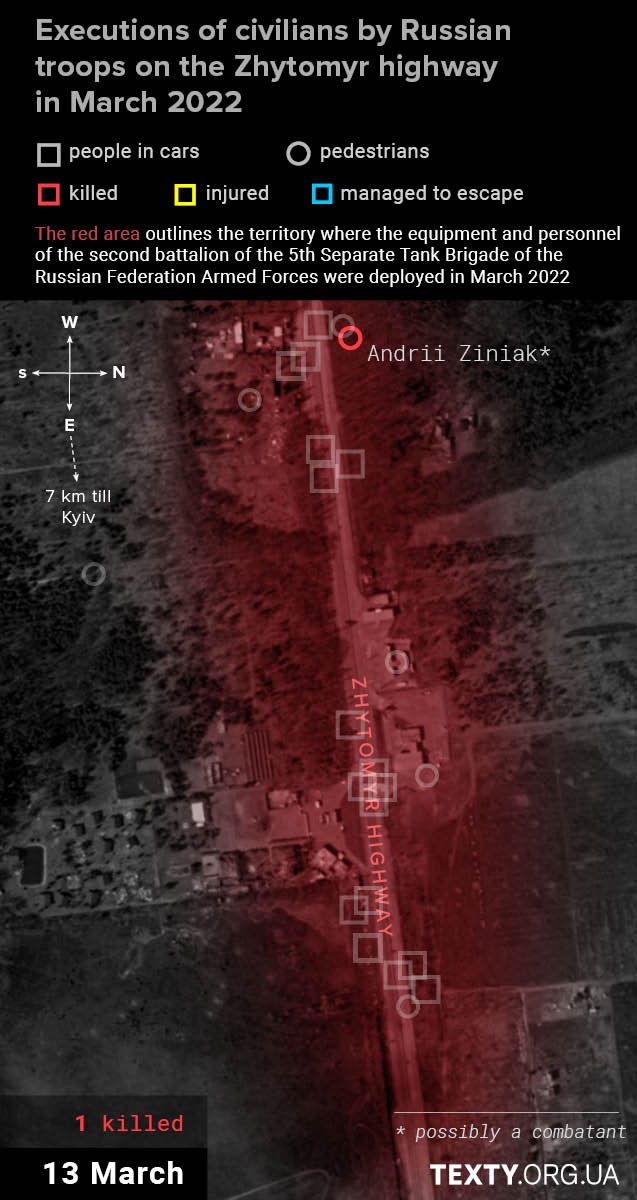
On this day, Russians shot dead a member of the local territorial defence, a veteran of the war in the east of Ukraine, 41-year-old Andrii Ziniak. He died of a piercing wound from under his left shoulder blade.
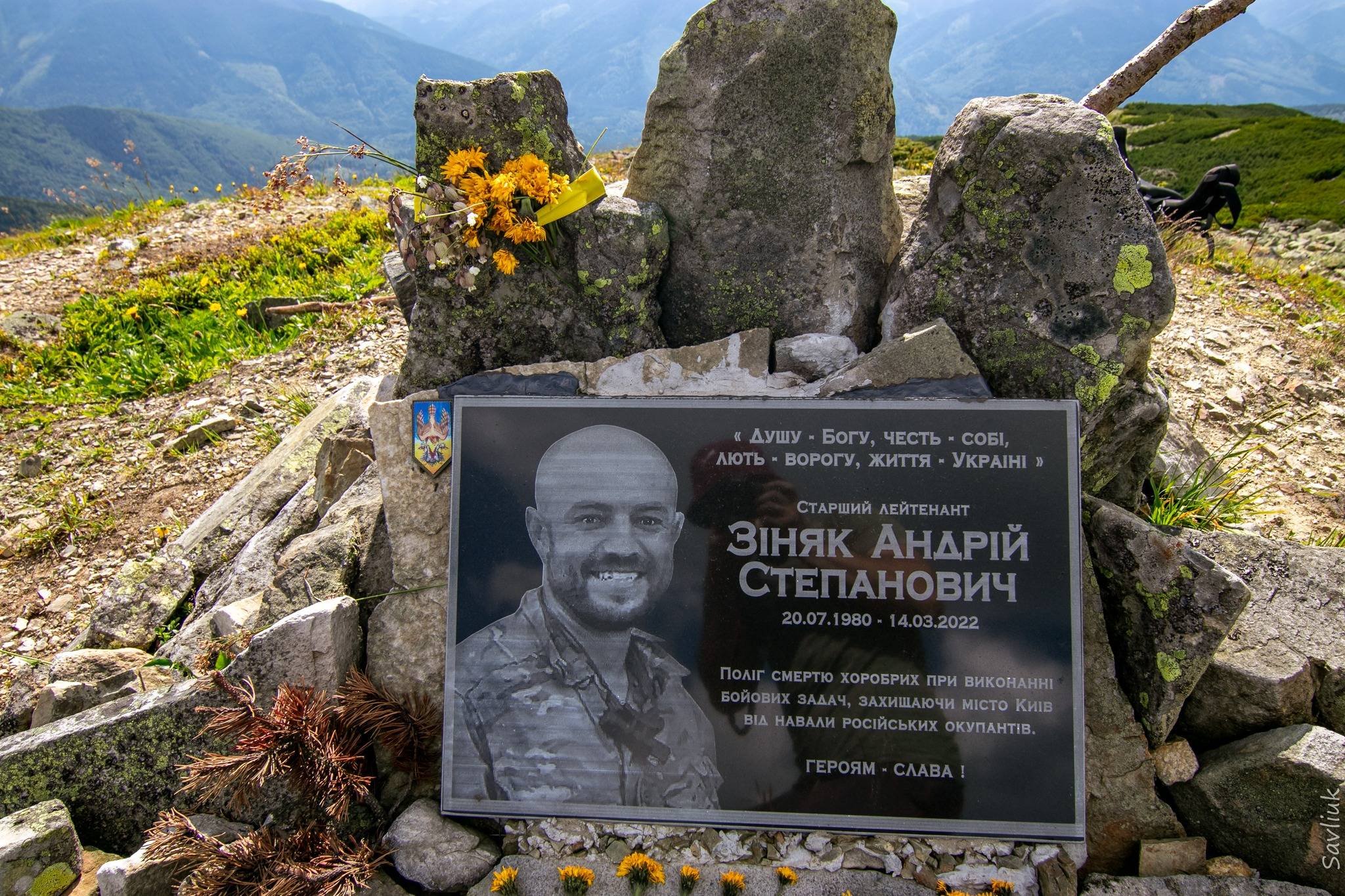
25 March, (at least) three people killed


Oleksandr Stepanechko in a Toyota Land Cruiser Prado
On this day, 45-year-old Oleksandr Stepanechko drove the Zhytomyr highway from Kyiv. Between 8 and 10 am, he approached a UPG petrol station. The Russians opened heavy fire. The man died on the spot. Experts recorded a bullet hit to the head. The car burned down.

Initial inspection of a Toyota Land Cruiser Prado and a body next to it on the Zhytomyr highway. Video: DENOTAT documentary group
Viktor Sukmaniuk and Liudmyla Pliuschyk in a Mitsubishi Lancer 9
Around 9 a.m., a married couple, Viktor Sukmaniuk and Liudmyla Pliushchyk, left the village of Hurivshchyna in the direction of Kyiv.
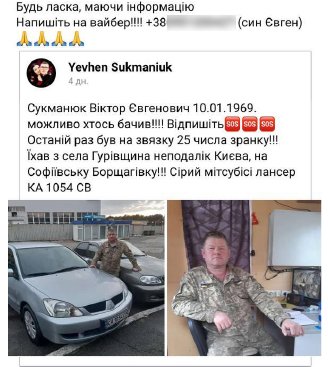
Before reaching the UPG petrol station, they came under fire. They died on the spot. After the attack, the Russians set the car on fire. According to investigators, the bodies were so burnt that it was extremely difficult to take genetic samples.
Initial inspection of the Mitsubishi Lancer 9 and the bodies nearby on the Zhytomyr highway. Video: DENOTAT documentary group
UNIDENTIFIED
The remains of 8 more bodies were found on this section of the road and in the area nearby, which have not yet been identified. Each of these eight people had gunshot wounds, all of them had been shot, almost all of them in the head. Almost all of them were then burned. However, the circumstances and time of their deaths remain unknown.


DNA samples were taken and added to a common database, but there were no matches. Investigator Alina Mashkina explained that many people whose relatives have gone missing do not go to the police and do not submit DNA samples because they still hope that their loved ones are alive. But for this reason, here and in other places where Russians have committed crimes, there are still many unidentified bodies, because the samples taken are not in the database.
We publish this footage to give people searching for their loved ones a chance to identify the bodies.
INVESTIGATION
"We were informed that cars had been shot at on the Zhytomyr highway near the UPG petrol station. Since we already had experience in Hostomel, we were given the task to collect all possible information," the Crimean police officers say about the start of the case.
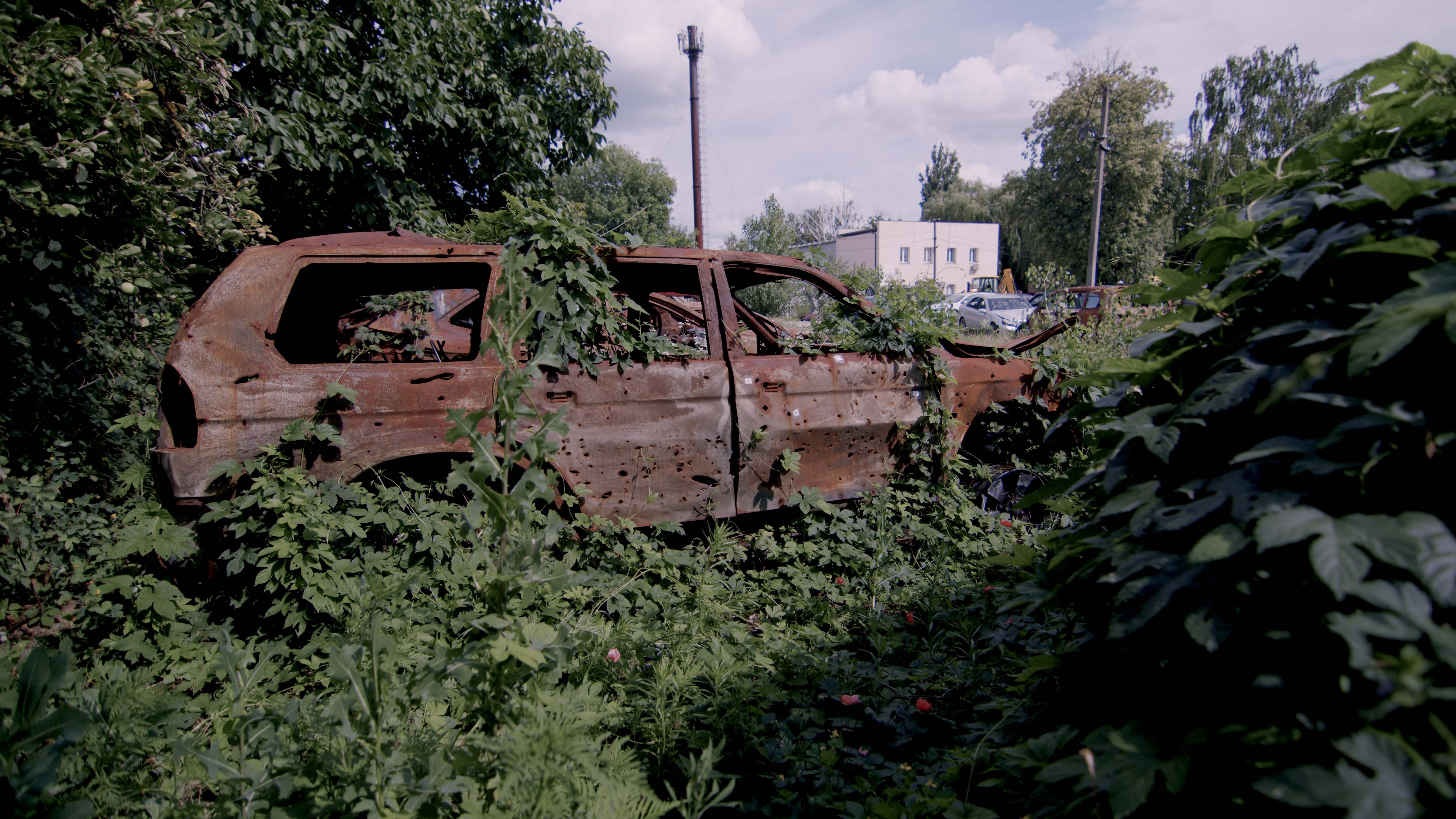
The collection of information began a few months after the de-occupation of the Kyiv region at the scene of the incident, on the Zhytomyr highway, "When we arrived, the road was like it is now," they say. "There were no photos, no information about the cars. Only the fact itself."
In the process, the operatives began collecting video footage from open sources and from their colleagues who had conducted an initial inspection in April 2022, as well as talking to people, first of all, the aforementioned "foresters", who reported that all 11 vehicles had been taken from the road to the village of Dmytrivka.
"There were a lot of different cars at the dump, they were dumped randomly," the operatives say about their first visit to Dmytrivka, "We started literally climbing through these cars, finding the remains of VIN codes, looking for any identification marks. It was hard to understand because the cars had been burnt, run over by machinery — just pieces of iron."
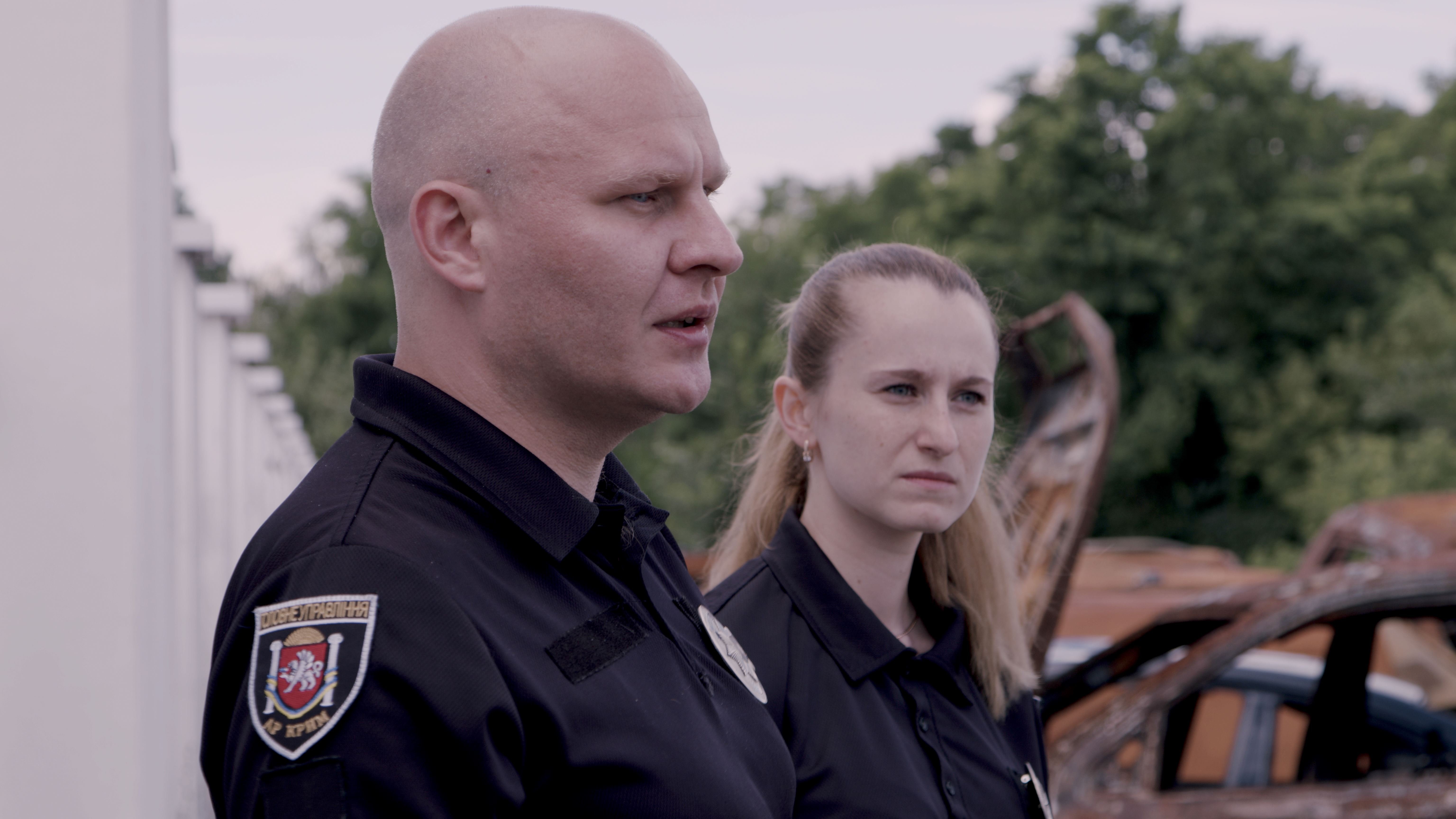
The exact dates of each victim's death were determined by investigators, comparing data from various sources: "Drone footage played a big role," says senior investigator Andrii Vyshniak.
Analysis of telephone traffic was equally important in determining the time of the murder, "All the people moving around here had mobile phones with them. Since we already had information about who had died and who was travelling by what means of transport, we found out the victims' phone numbers and determined when they made their last calls from each phone. Putting all the evidence together, we determined the exact dates and approximate time of death," adds senior investigator Alina Mashkina
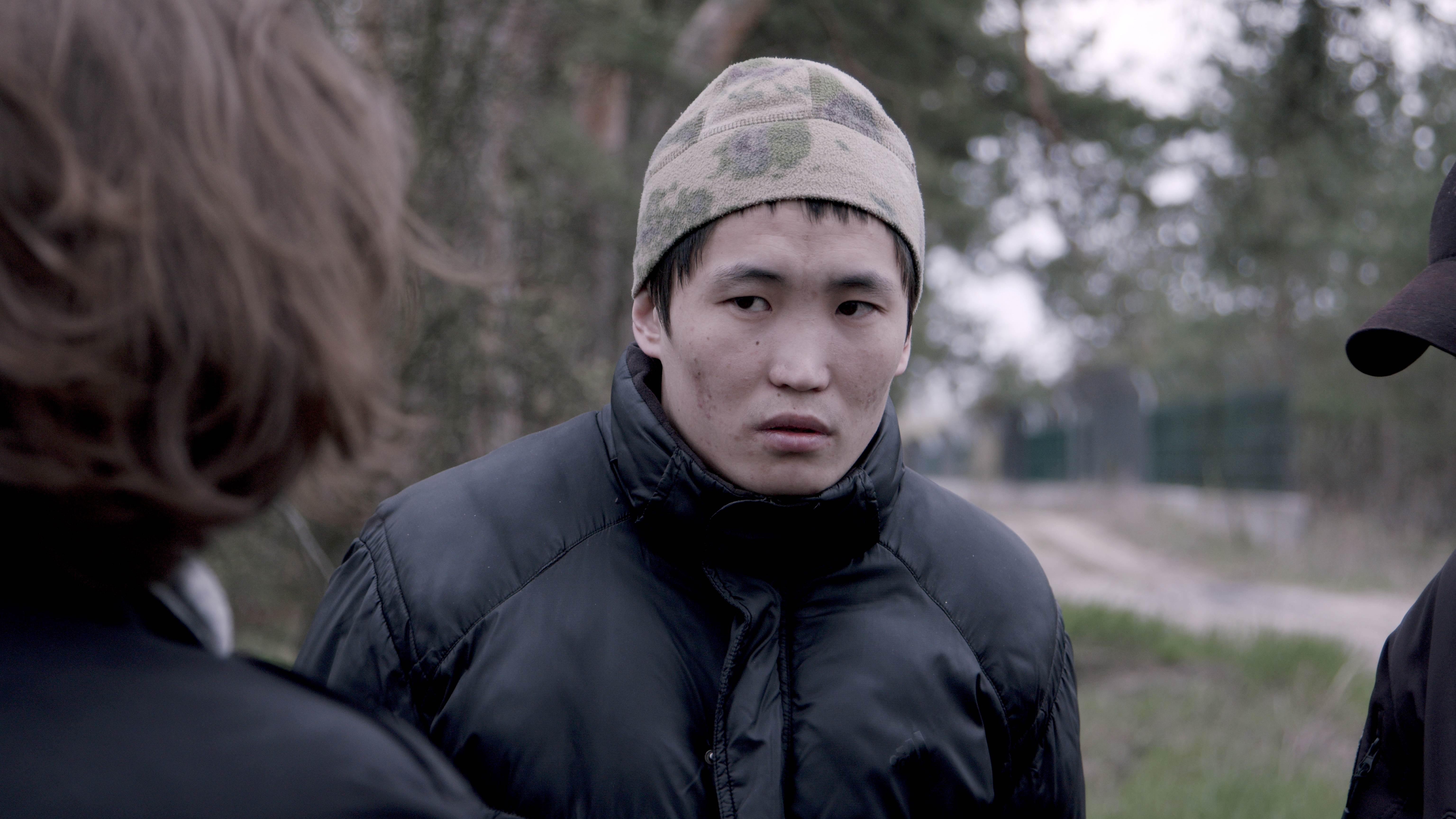
According to the police, a total of about 200 investigative actions were carried out in this case: photo identification, interrogations of victims and witnesses, reenactments of events, and numerous inspections. Ballistic examination established that the smallest number of hits to the vehicles in this area was 50, and the largest number was about 90. "There are entry holes on both sides — the fire was from both sides of the road," says Alina Mashkina.
Investigator Andrii Vyshniak adds, "The Russians didn't care whether it was a woman or a child — they carried out these shootings cruelly, brazenly, with special cynicism... Then the Russians burned all the cars to hide the traces of their criminal actions." Police officers said that some bodies were so destroyed by fire that only a few bones were taken to the morgue.
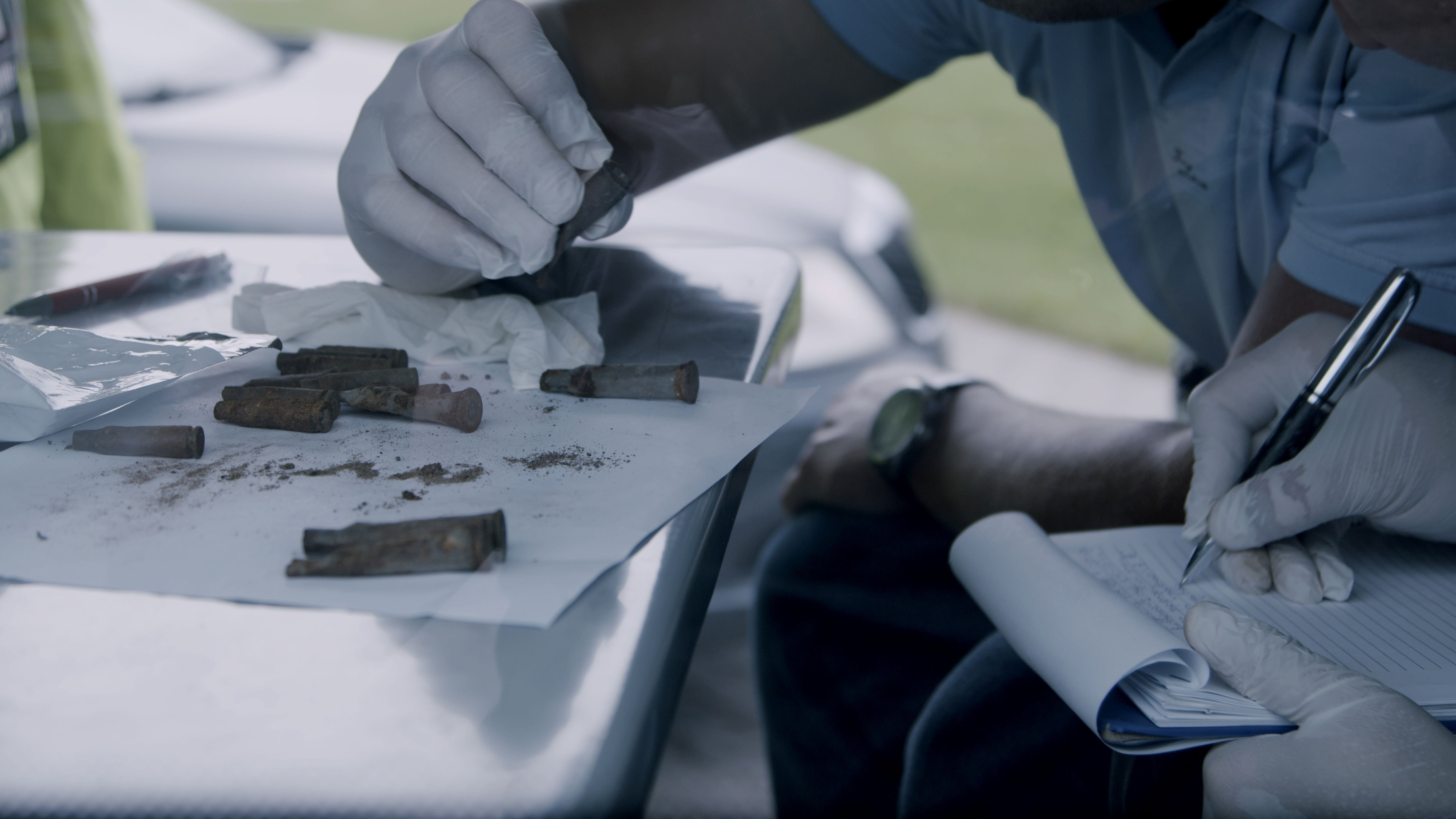

RUSSIAN MILITARY
Having primary documentation, data from operatives, data from dozens of examinations, investigative experiments, and interrogations of witnesses and Russian prisoners of war, investigators began to draw up the pre-trial investigation in the “Notice of Suspicion” text.
Based on the information gathered, they determined that the crimes on the Zhytomyr highway were committed by members of the 2nd Battalion of the 5th Separate Tank Guards Tatsyn Red Banner Order of Suvorov Brigade of the 36th Combined Arms Army of the Eastern Military District of the Russian Federation, following the order of their direct commander, Major Tkharo Abatayev.
"We can say for sure that the crimes here were committed with the participation of servicemen acting under the command of Tkharo Abatayev. He directly commanded and gave commands to shoot civilians moving on the road or in places where Russians were stationed," says investigator Alina Mashkina.
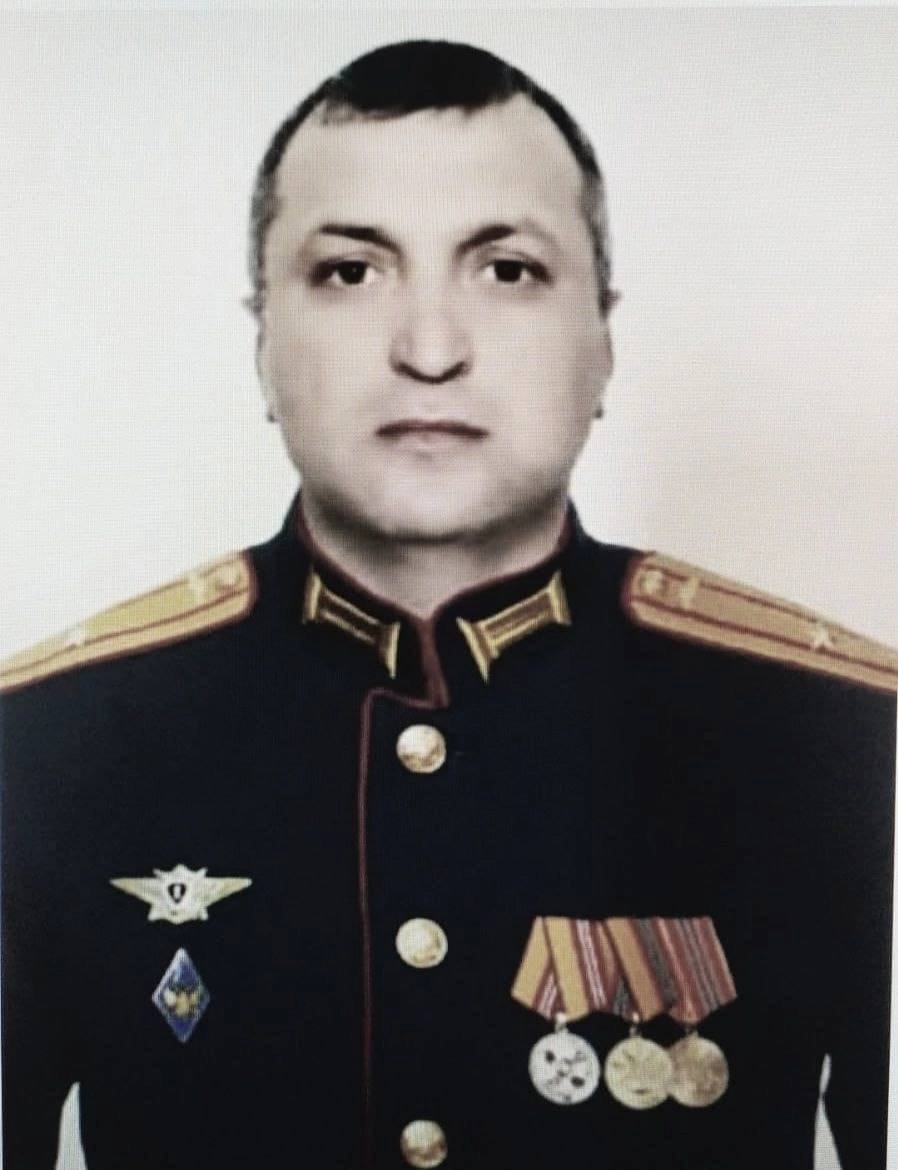
Abatayev Tkharo Alimovich
He was born on 04.02.1982 in Makhachkala, Republic of Dagestan, Russian Federation. The commander of the 2nd Battalion of the 5th Tank Brigade of the 36th Combined Arms Army of the Eastern Military District of the Russian Federation Armed Forces. Military unit No. 46108, stationed in Ulan-Ude, Republic of Buryatia, Russian Federation.
Of course, there were periodic rotations of personnel, but the unit did not change: the same 2nd Battalion of the 5th Separate Tank Brigade, consisting of about 300 people, was permanently deployed in the area of the UPG petrol station until the end of March. The police managed to collect chevrons of the 5th Separate Tank Brigade, documentation, duty schedules with names and, in addition to Abatayev, identified dozens of his subordinates.
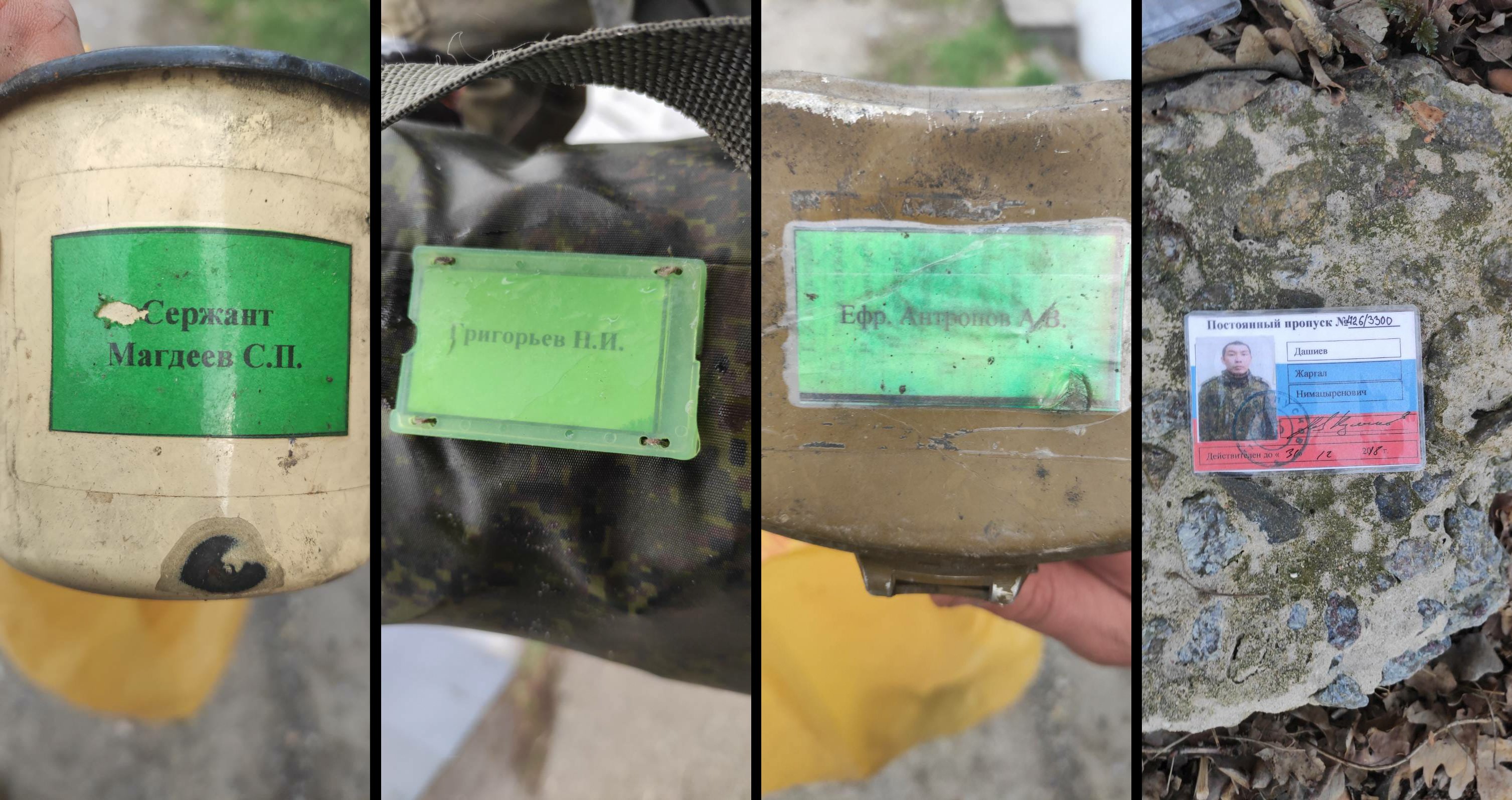
Among those identified are Daniil Ishchenko and Chingis Taryashinov.
Daniil Ishchenko
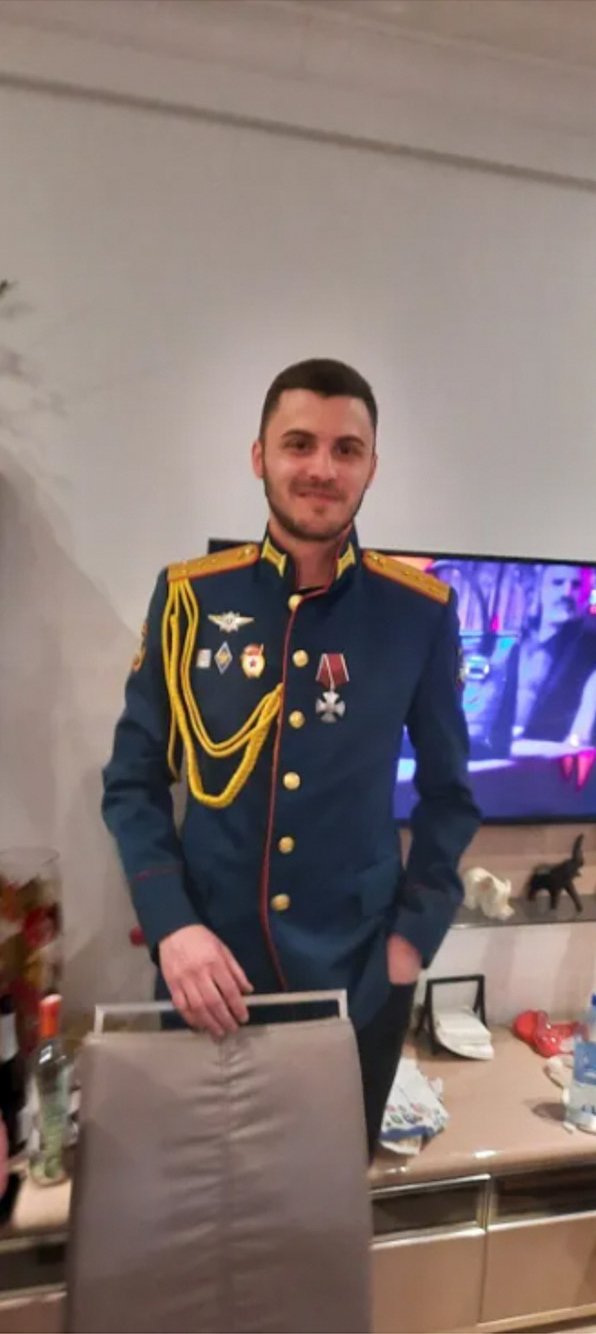
He was born on 18 January, 1996 in Ulan-Ude, Republic of Buryatia, a citizen of the Russian Federation. Senior lieutenant, commander of the 2nd tank platoon of the 4th tank company of the 2nd battalion of the 5th Tank Brigade.
Chingis Taryashinov

He was born on 10.03.1988 in Ulan-Ude, Republic of Buryatia, a citizen of the Russian Federation. Lieutenant, senior gunner of the 6th gun of the 2nd howitzer self-propelled artillery platoon of the 1st howitzer self-propelled artillery battery of the howitzer self-propelled artillery battalion of the 5th Tank Brigade.
On 14 February 2023, Ishchenko and Taryashynov were notified of suspicion under Article 438(2) of the Criminal Code of Ukraine, "Cruel treatment of civilians and other violations of the laws and customs of war," in particular for the murder of Maksym Iovenko and Kseniia Tsaturova on 7 March, and the wounding of Nataliia Melnyk and Vira Rykal. According to the evidence gathered, it was Taryashinov and Ishchenko who fired the shots. "These two belonged to the 2nd battalion, they were stationed here. They were the ones who made the shots, and the victims identified them," Crimean police investigators said.
Their commander, Tkharo Abatayev, was also served with a notice of suspicion for ordering the shooting of civilians. The text of the suspicion was announced on 29 December 2022. Then, according to the investigation, Abatayev was suspected of killing three people: Olena Stotska, Maxim Iovenko and Kseniia Tsaturova, as well as the injury of Serhii Stotsky, his daughter, Dmytro Tolok, Vira Rykal and Nataliia Melnyk.
Today, Abatayev was informed of a new, supplemented suspicion. The Russian commander is still accused under Ukraine’s Article 438, paragraph 2, of "ordering the commission of cruel treatment of civilians, combined with premeditated murder." But now, according to investigators, he is suspected of killing 13 civilians, including: Olena Stotska, Maxim Iovenko, Kseniia Tsaturova, Vasyl Harashchuk, Valentyn Hrabchak, Olena Husakovska, Volodymyr Panov, Bohdan Komarovsky, Viktor Sukmaniuk, Liudmila Pliushchyk, Oleksandr Stepanechko, Serhii Kabashny and Oleksandr Shelykh.
According to the investigators, after the de-occupation of the Kyiv region, Abatayev and his subordinates retreated to Belarus, and from there to the city of Ulan-Ude. Their fate is not known for certain. However, Russian websites contain information that Abatayev died, was posthumously awarded the Order of Courage, and even named a school in Makhachkala in his honour.
The video shows the unveiling of a memorial plaque to Tkharo Abatayev at school 27 in Makhachkala. Audio: sounds of gunfire on the Zhytomyr highway in March 2022
The actions of the 2nd Battalion of the 5th Separate Tank Brigade in the area around the UPG petrol station killed at least 27 people and injured five others. Other battalions of the 5th Brigade were further along the road; their positions stretched from the village of Buzova to almost Stoyanka, which is about 15 km away. And wherever they were stationed, there were killings and injuries: in the village of Buzova, civilian pedestrians were shot dead; in the village of Berezivka, a volunteer was shot dead... These and many-many other murders are still under investigation.


Post scriptum
For the Russian military, a killed or wounded civilian is not a separate universe but just an extra hassle that may one day lead to accountability.
This is especially clear at the car dump in Dmytrivka: the frames of rust-covered vehicles have been burnt to ashes, shot at, and run over by heavy machinery. All the skeletons of the cars have many holes, and some of the holes have numbers 50, 51, 52... The number of hits from different weapons. The number of hits to men, women and children.
Here and there, on wheel rims, trunks, or steering wheels, the cigarette butts of car signs, dusty and cobwebbed, glisten surrealistically: Volkswagen, Kia, Mitsubishi, Toyota... But absolutely all the cars here have the Russian sign: either literally, in the form of a painted V, or metaphorically, in bullet holes, in the blood of Ukrainians baked on the seats.
And in the disturbing ashes, the memory of people tortured by a terrible death is still physically present.
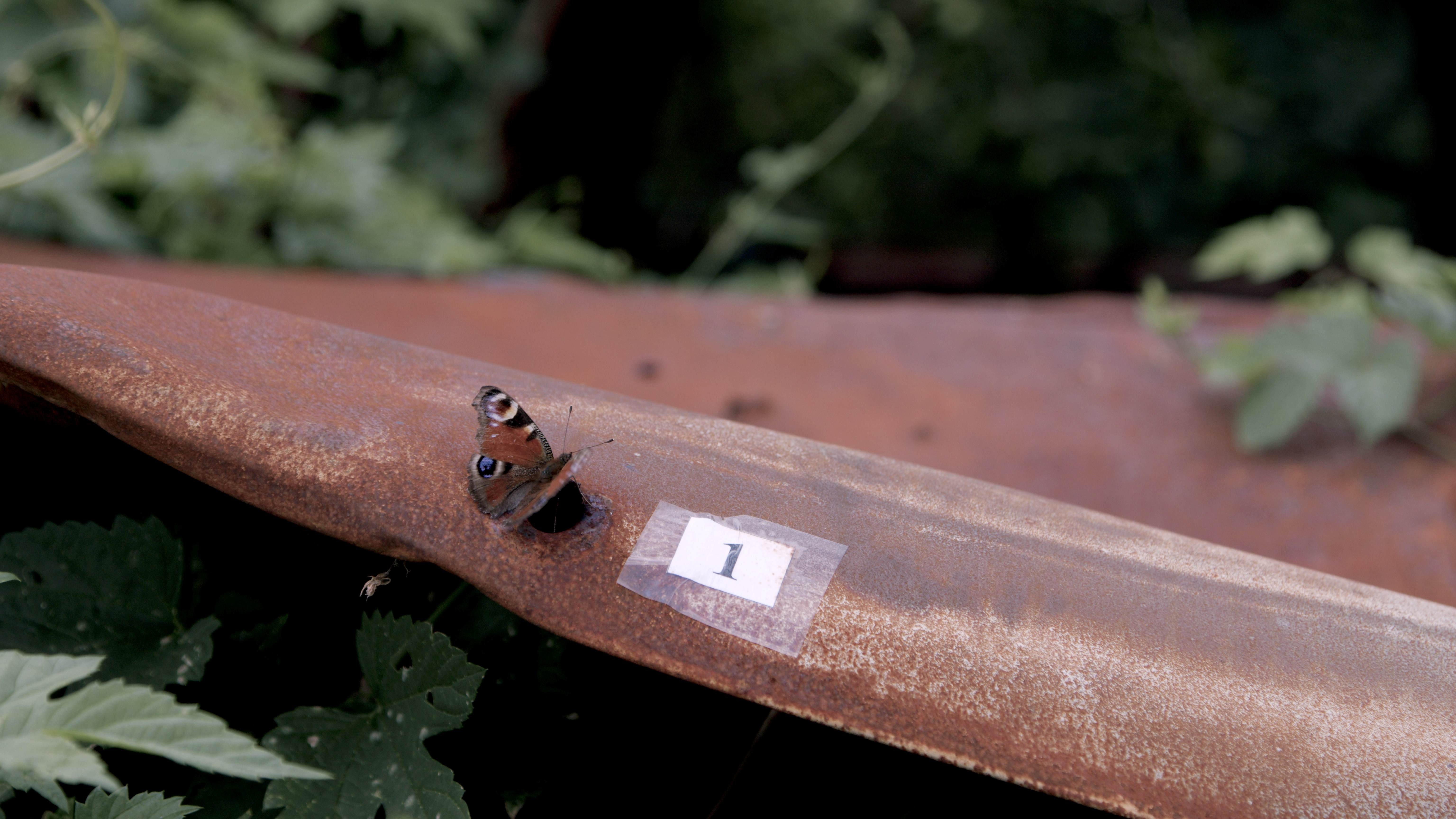
Author: Taras Lazer
Maps and graphics: Nadia Kelm
Interactive and layout: Evheniia Drozdova
Translation: Anastasiia Marushevska

